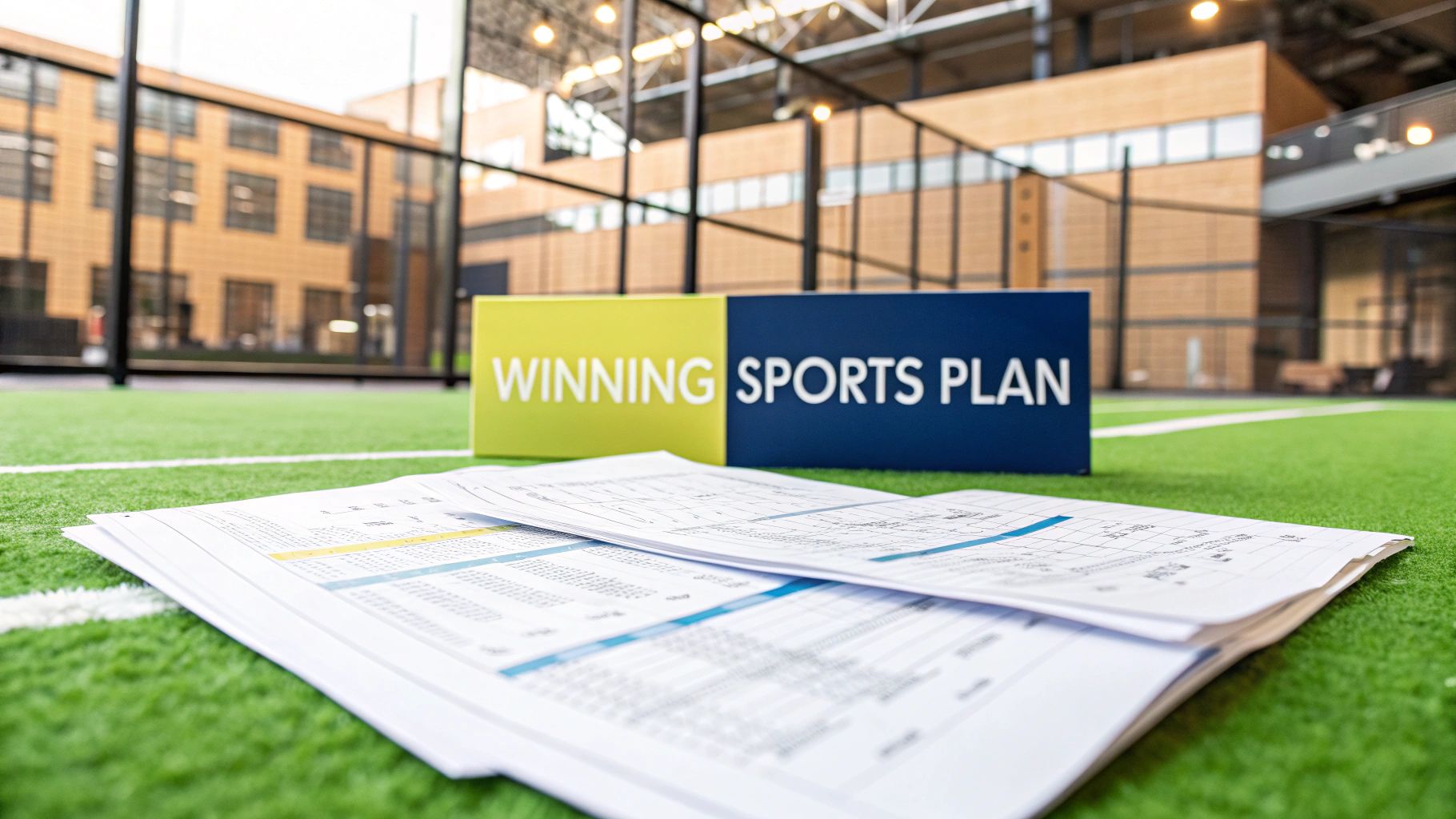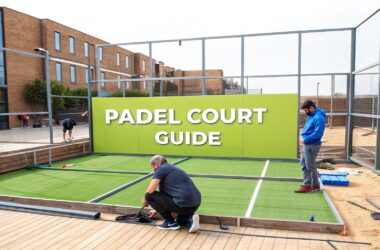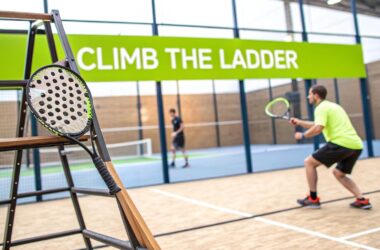Starting a sports facility is way more than just a passion project—it’s a serious business venture, and it demands a detailed roadmap. That roadmap is your sports facility business plan. Think of it as the essential blueprint that translates your vision into a bankable strategy, spelling out everything from market analysis to financial projections and operational logistics.
This is the foundational document you'll lean on to secure funding and guide every single decision, from the initial concept all the way to opening day.
Why Your Sports Facility Business Plan Is Your Most Valuable Asset
Don't think of your business plan as some static, one-and-done document. It's a dynamic playbook for success. Honestly, it's the most critical first step in turning a great idea into a tangible, profitable business.
Without one, you're basically navigating a competitive market blind. That’s a surefire way to make costly mistakes and miss out on huge opportunities. A well-researched plan forces you to validate all your assumptions with hard data before you sink any significant capital into the project.

Buy the best padel gear to level up your next game!
CHECK OUT this deal from Padel Market!Get ready to take your game to the next level with the latest padel gear from Padel Market! Fast EU and Worldwide Shipping
This document does a few crucial things for you:
- Securing Investment: This is your number one tool for convincing investors, lenders, and partners that your facility is a sound financial bet. A detailed plan screams professionalism and foresight.
- Guiding Strategy: It lays out a clear path forward. It defines your mission, your objectives, and the specific actions you need to take to hit your goals.
- Measuring Success: It establishes key performance indicators (KPIs) and financial benchmarks. This is how you'll track your progress and make smart, informed adjustments on the fly.
- Aligning Your Team: It makes sure everyone, from your management team to your front-desk staff, understands the facility’s goals and exactly how they fit into the big picture.
A truly solid sports facility business plan is built on two things: thorough market research and realistic financial forecasting. For instance, before you even think about launching a new padel club, you need to be analyzing local demographics, checking out competitor pricing, and figuring out the potential demand. This initial legwork is absolutely crucial, as there are many key aspects to consider when opening a padel venue that can make or break your entire venture.
A common mistake I see entrepreneurs make is jumping straight to designing the facility—picking out turf and drawing up court layouts—without first proving the idea is financially viable on paper. Your business plan is the ultimate reality check, ensuring your passion is backed by a profitable model.
Ultimately, this blueprint isn't just about getting a check from an investor. It’s about creating a sustainable business that becomes a thriving hub for your community for years to come. It prepares you for the inevitable challenges, shines a light on hidden opportunities, and gives you the strategic clarity you need to win.
Validating Your Idea With Market Research
Before you pour a single yard of concrete or even think about signing a lease, you need proof. You need to know, without a doubt, that people will actually show up and pay to use your sports facility. The only way to get that proof is by doing your homework with thorough market research.
This isn't about confirming a gut feeling. It's about gathering cold, hard data to build an undeniable case for your venture. This foundational work will steer every other part of your business plan, from your financial projections to how you'll get the word out.
Identifying Your Target Audience
First things first: who are you building this for? You have to get specific. Are you aiming for the serious league players, families looking for a fun weekend activity, or maybe even corporate clients for team-building events? Each group has totally different needs, expectations, and spending habits.
To figure this out, you need to map out your catchment area—the geographic zone where most of your customers will come from. A good rule of thumb I've seen work time and again is the "22-minute rule." Most people simply won't drive more than 22 minutes for a regular recreational activity.
Use mapping tools to draw that 22-minute circle around your potential locations. Then, you can start digging into the demographics within that zone.
Look for these key indicators:
- Population and Age: Are there enough people in the right age groups? A padel club targeting young professionals needs a different demographic mix than a multi-sport complex for families.
- Household Income: This is crucial. It directly impacts how you'll price your memberships, court rentals, and everything else.
- Lifestyle Data: Search for community stats on sports participation, gym memberships, and general spending on recreation. This tells you if you're tapping into an active, engaged community.
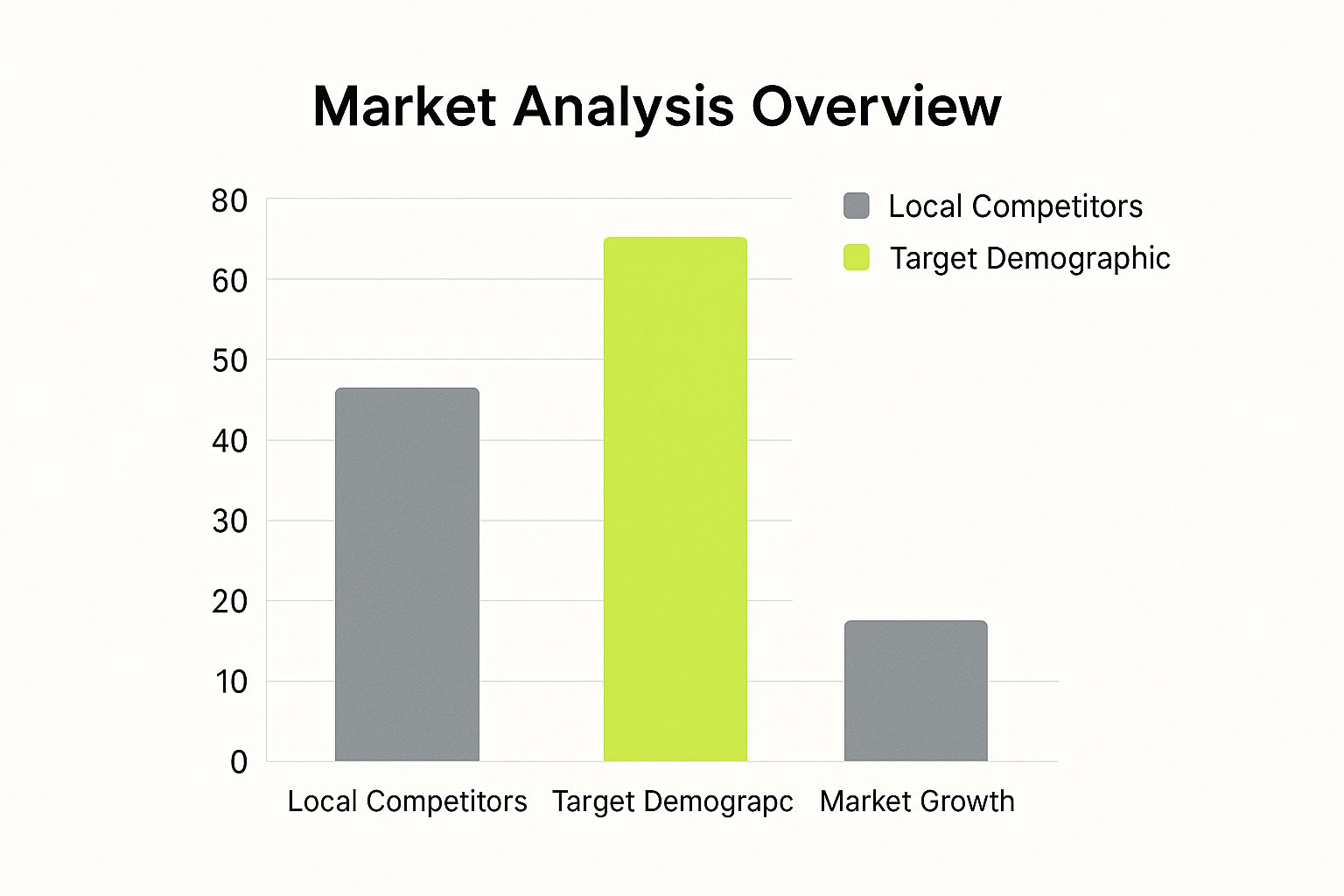
This kind of visualization is exactly what you should be aiming for. It cuts through the noise and shows a clear picture: moderate competition, a high concentration of your target audience, and a strong growth rate. That’s the sweet spot you're looking for.
Analyzing The Competitive Landscape
Now, it's time to size up the competition. Make a list of every direct and indirect competitor in your catchment area. Don't just list their names—get out there and investigate. Visit their facilities, see what people are saying in online reviews, and break down their pricing.
A huge mistake I see entrepreneurs make is ignoring indirect competition. If you're opening a padel club, you aren't just competing with other padel clubs. You're fighting for a share of the community's recreational budget against the local tennis center, the CrossFit gym, and even the movie theater.
I recommend building a simple competitor analysis matrix. Compare them on things like facility quality, the variety of programs they offer, and pricing. Your goal is to find a gap in the market—that's your golden ticket.
For instance, I know of a new padel center in Lisbon that did this perfectly. They saw plenty of high-end clubs, but a rapidly growing, family-heavy neighborhood had nothing. They targeted that underserved area, partnered with local schools, and had a massive member list before the doors even opened.

Buy the best padel gear to level up your next game!
CHECK OUT this deal from Padel Market!Get ready to take your game to the next level with the latest padel gear from Padel Market! Fast EU and Worldwide Shipping
This detailed groundwork is absolutely essential. The market is exploding, and you need a solid plan to grab your piece. Take a look at the projected growth in the sports facilities market.
Projected Sports Facilities Market Growth
The global sports facilities market is on an incredible upward trajectory. Modernization and the push for diversified revenue streams are fueling massive expansion, presenting a prime opportunity for well-planned new ventures.
| Timeframe | Market Value (USD Billion) | CAGR |
|---|---|---|
| 2024 | 132.4 | – |
| 2034 | 1,084 | 23.4% |
Source: market.us
That 23.4% compound annual growth rate is staggering. To succeed in this booming market, your business plan has to be built on a rock-solid foundation of data proving you can compete and win.
Building Your Financial Projections And Revenue Model
Okay, you’ve confirmed there’s a real appetite for padel in your area. Now comes the part that separates the dreamers from the doers: translating that potential into cold, hard numbers. This is where your sports facility business plan evolves from a great idea into a serious investment opportunity. Investors aren’t just buying into the hype; they need to see a clear, believable path to profitability. That means building a rock-solid financial model.
You'll be forecasting everything—from the initial cash you'll burn getting the doors open to your long-term operational cash flow. We're talking startup costs, ongoing expenses, and, of course, all the ways you'll make money. This financial blueprint isn't just a document to get you funded; it's your roadmap for making smart decisions once you’re up and running.
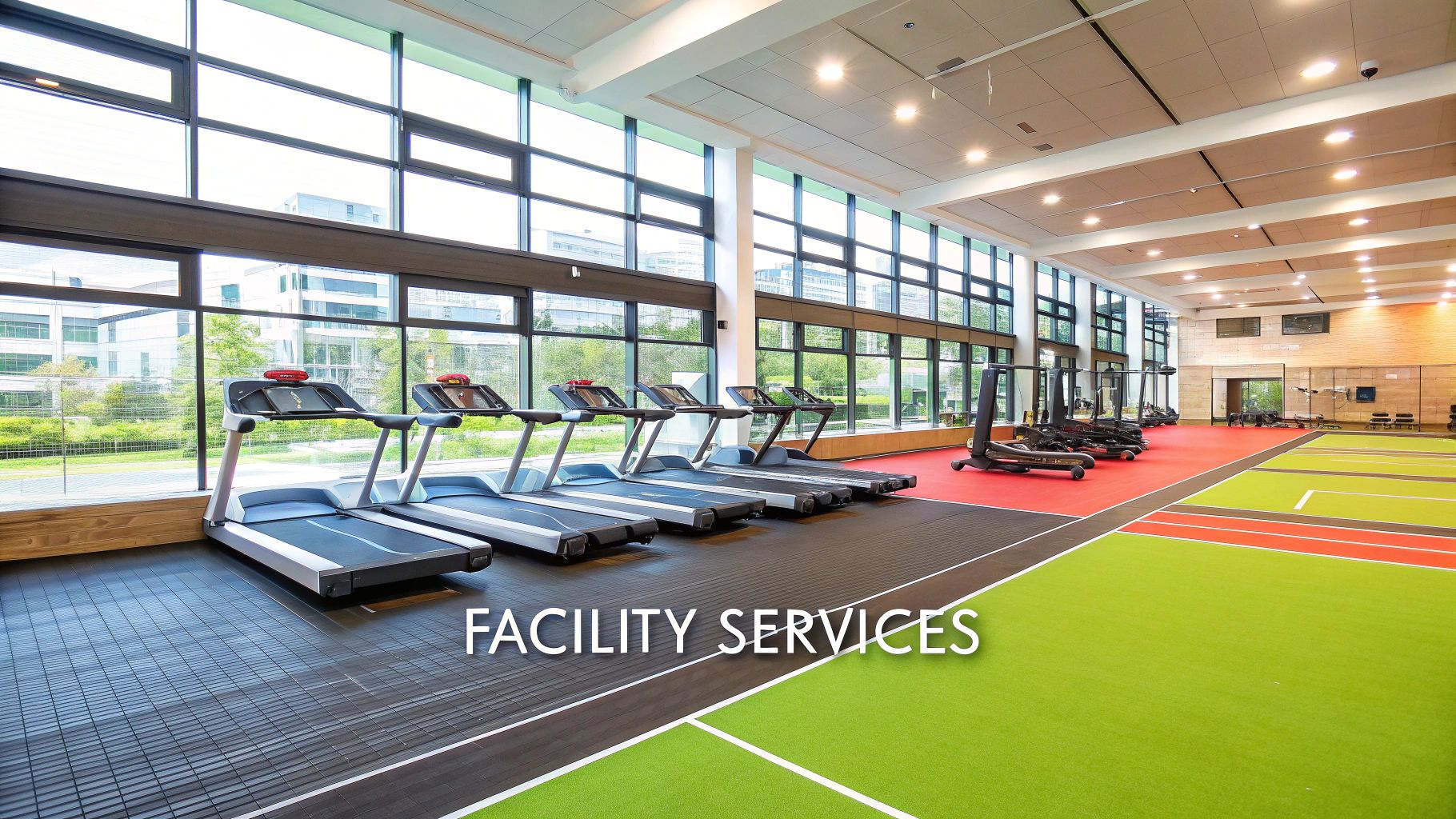
Forecasting Startup And Operational Costs
First things first, let's nail down all the one-time expenses needed to launch. You need to be brutally honest and thorough here to avoid nasty surprises down the line.
Your main startup costs will likely include:
- Facility Construction or Renovation: This is almost always the biggest ticket item. A deep dive into https://padelrumors.pages.dev/news/padel-court-construction-cost/ is a great place to get a realistic baseline for your projections.
- Equipment Purchases: Think beyond the courts. This includes everything from rackets and balls for a pro shop to your booking software and the espresso machine for the cafe.
- Initial Marketing and Launch Events: You need a budget to build buzz before you open. A strong start is critical.
- Professional Fees: Don't forget to account for the lawyers, architects, and consultants who will help you get this off the ground.
Once you have that list, it's time to map out your recurring operational expenses. These are the monthly costs of keeping the lights on and the business humming along—staff salaries, utilities, insurance, ongoing marketing, and software subscriptions.
Designing Your Revenue Streams
With costs understood, we get to the fun part: figuring out how you’ll bring in the cash. The key to a resilient business is having multiple streams of income. If you rely only on court rentals, one slow month could put you in a tough spot.
A smart, multi-faceted approach looks something like this:
- Court Rentals: This is your bread and butter. Use your market research to set competitive hourly rates. I highly recommend dynamic pricing for peak vs. off-peak hours to keep courts full.
- Memberships: This creates predictable, recurring revenue you can count on. A mid-sized club I worked with boosted its revenue per user by 15% simply by introducing tiered memberships (like Basic, Premium, and Corporate) with different perks.
- Event Hosting: Tournaments, leagues, and corporate events are cash cows. They also serve as fantastic marketing, bringing new faces into your facility who might just become members.
- Coaching and Clinics: Offering lessons for all skill levels is a high-margin service that adds tremendous value for your customers.
- Ancillary Sales: Never underestimate the power of a well-stocked pro shop, a cozy café, or even just vending machines. These small purchases really add up.
Your financial model needs to tell a compelling story. It should walk an investor through not just what you'll earn, but how you'll earn it and why your numbers are grounded in the market data you’ve gathered.
Building Realistic Financial Scenarios
No business plan is worth its salt without data-driven financial projections. You need to show you've thought this through. A standard five-year forecast including an income statement, cash flow statement, and balance sheet is what investors expect to see. If you're new to this, it's worth the time to master your business plan financial projections.
I always advise clients to prepare at least two scenarios: a conservative "base case" and a more optimistic "stretch goal." This shows you've considered potential bumps in the road and aren't just wearing rose-colored glasses. It tells investors you're prepared, not just hopeful.
The global sports market is booming, with projections showing it could hit USD 617.57 billion by 2029. This growth is being driven by technology and a demand for better customer experiences. A forward-thinking business plan will show how you'll capture a piece of that pie with smart pricing and top-notch amenities. That’s what separates a good financial model from a great one.
Designing Your Operations And Management Plan

Let's get down to the brass tacks. Your financial projections in the sports facility business plan are just numbers on a page until you figure out how you're actually going to pull it off. A brilliant concept can fall flat without a rock-solid operational strategy.
This part of your plan is all about the "how"—the day-to-day processes, the team you’ll build, and the upkeep that will turn your blueprint into a thriving, customer-first business. Think of your operations plan as the engine of your facility. It covers everything from the physical layout to the tech that powers your bookings. A smart plan makes life easier for your staff and your players, which directly hits your bottom line.
Defining Daily Workflows And Staffing Needs
First things first, you need to map out a typical day. Who’s opening up? Who’s handling check-ins, answering the phone, and managing league sign-ups? Even if you're starting with a skeleton crew where everyone wears multiple hats, you need to define these roles clearly from day one.
Next, you have to build a staffing model that matches your peak hours. Your market research should have told you when you'll be busiest—usually evenings and weekends. Don't make the classic mistake of understaffing during these crucial times. It’s a fast track to poor service and leaving money on the table.
Your staffing plan needs to spell out:
- Roles and Responsibilities: Get specific. What exactly does the front desk person do? The coaches? The maintenance crew?
- Scheduling: Create a flexible schedule that can handle the rush but also scale back during quiet periods.
- Training Programs: How will you get new hires up to speed? Focus on exceptional customer service and mastering your facility’s software.
I once worked with a club that slashed court downtime by a massive 30%. Their secret? They simply created a preventive maintenance checklist for staff to run through during slow periods. This kept the courts in prime condition and helped them dodge expensive emergency repairs.
Optimizing Facility Layout And Equipment
The physical flow of your club matters more than you might think. A logical layout that guides people from the entrance to the check-in desk, locker rooms, courts, and bar just feels professional. It cuts down on confusion and makes the whole experience smoother and more welcoming.
When it comes to equipment, don't just chase the lowest price. Your courts, lighting, and rental rackets are the core of the player experience. Investing in durable, high-quality gear will save you maintenance headaches down the road and signal to your members that you're serious about quality.
Integrating Technology For Seamless Operations
In this day and age, technology isn't optional. The top venues are already integrating features like 5G and in-app services to get ahead. According to PwC's sports industry trends, tech is central to the modern fan experience, and your facility is no different.
The heart of your tech setup will be your management software. A good system handles online bookings, membership management, payments, and staff schedules all in one place. It doesn’t just automate the boring stuff; it gives you incredible data on court usage and player habits.
To get a handle on the best options out there, check out our guide on sports facility management software. Choosing the right platform from the start is one of the smartest moves you can make for operational excellence.
Developing Your Marketing And Sales Strategy
So, you've got pristine courts and a team ready to go. Great. But an empty facility doesn't pay the bills. This part of your sports facility business plan is all about one thing: getting people through the door and keeping them coming back.
We're not just talking about running a few ads here. You need a real plan to create buzz, drive sign-ups, and turn those first-time players into the heart and soul of your club. A successful launch starts generating excitement long before you even open for business.
Crafting A Multi-Channel Launch Campaign
Your marketing push needs to kick off months before your grand opening. The whole point is to build a waitlist of players who are genuinely excited to play. This pre-launch phase is your secret weapon for generating that crucial initial cash flow and proving to investors that you knew what you were talking about in your market research.
A good game plan mixes the digital world with old-school, on-the-ground tactics.
- Build Your Digital Home: Grab your social media handles on platforms like Instagram and Facebook right away. Start posting behind-the-scenes stuff—construction progress, team introductions, anything that tells your story. Run targeted ads zeroing in on people within that 22-minute drive who are already into sports, fitness, or local events.
- Team Up Locally: Get to know your neighbors. Connect with local businesses and pitch them on a corporate wellness package. Partner with a nearby café for a cross-promotion. These relationships are gold for building credibility in the community.
- Get Out There: Why not sponsor a local youth sports team? Or set up a small booth at a town festival? Handing out flyers with an "early bird" membership discount is a surprisingly powerful way to build that initial email list.
I once worked with a new padel club that absolutely nailed their launch. They boosted their initial sign-ups by a whopping 25% over their own projections. How? They used personalized email campaigns. They split their pre-launch list into groups and sent messages that actually spoke to them—one for competitive players about upcoming leagues, another for families highlighting weekend clinics. It worked like a charm.
Segmenting Your Audience For Maximum Impact
Let's be real: not all players want the same thing. A generic, one-size-fits-all message is a recipe for being ignored. The trick is to slice up your audience and talk to each group about what they actually care about.
Think about the different types of people you'll see on your courts:
- The Social Player: This crew is here for a good time, a light workout, and to meet people. You'll hook them with social mixers, "get to know you" nights, and promos that scream "fun."
- The Competitive Player: These are the die-hards. They live for competition and getting better. They’ll be all over your league announcements, tournament schedules, and coaching clinics with experienced pros.
- The New Player: Beginners need to feel welcome, not intimidated. Attract them with "Intro to Padel" classes, beginner-only court times, and easy equipment rental packages.
Your website, your social media, your flyers—everything should reflect this. Use images and words that resonate with the specific group you're targeting. It shows you're not just selling court time; you actually get them.
Turning Members Into Marketers
Your single best marketing tool isn't an ad campaign; it's a happy member. A solid referral program isn't just a nice-to-have, it's essential for growing your club without breaking the bank.
Give people a real reason to spread the word. Offer something good for both the person referring and the new member they bring in. Think a free month, pro shop credit, or a few hours of free court time.
Make it dead simple. Give every member a unique link they can text or email to their friends. This approach dramatically lowers how much it costs you to get a new member, and the people who sign up are already warmed up because they trust their friend's recommendation.
Securing Funding For Your Sports Facility

This is it. This is the moment your vision has to meet reality. You’ve done the hard work of validating the market, meticulously crunching the numbers, and mapping out every operational detail. Now, it's time for the final piece of the puzzle: securing the capital to bring your sports facility business plan to life.
Forget the idea of just "asking for money." Your job is to present an undeniable investment opportunity.
Your business plan is the key that unlocks these critical conversations. It’s the proof that you’ve done your homework and have a clear, credible roadmap to profitability. Whether you're walking into a bank or sitting down with a private investor, this document shows you're a serious entrepreneur, not just a sports enthusiast with a dream.
Identifying The Right Funding Mix
Very few facilities get built with a single cheque. The smart approach is to build a "funding stack"—a combination of different types of capital. Each source has its own pros and cons, and diversifying your approach lowers your risk and dramatically improves your odds of getting fully funded.
Some of the most common funding sources include:
- Traditional Bank Loans: Often the first stop, especially if you have solid credit and some of your own capital to put in. Banks will pour over your financial projections and need to see a crystal-clear plan for repayment.
- Equity Investors: These are partners who provide cash in exchange for a slice of ownership in your business. They're betting on your long-term success and are looking for a significant return on their investment down the road.
- Sponsorship Deals: Never underestimate the power of local and corporate sponsorships. Selling naming rights to a court, getting a brand on your staff uniforms, or creating sponsored tournaments can bring in a serious amount of non-dilutive cash upfront.
A huge mistake is chasing just one type of funding. By talking to banks, seeking out angel investors, and pre-selling corporate sponsorship packages at the same time, you create leverage. This can create a competitive environment that often leads to much better terms for you.
Preparing A Compelling Pitch
Your full business plan might be dozens of pages long, but investors and lenders don't have that kind of time. You need a short, powerful way to tell your story. This is where a sharp pitch deck and a one-page financial summary are worth their weight in gold. They distill your entire plan down to its most persuasive highlights.
Think about what an investor sees first. They want the big picture, fast. This is why you need to lead with the most important numbers.
Take a look at the image below. It immediately shows the total funding goal, how much has been raised, and the key return metrics. This gives a potential investor a clear, quick snapshot of the opportunity without having to read a single paragraph.

I once saw a startup padel facility secure a €500,000 investment by boiling their pitch down to two things: a clear five-year payback timeline backed by conservative forecasts and the positive community impact of creating a new local hub. Their story wasn't just about ROI; it was about building a valuable community asset people would love.
To help you figure out the best path, here’s a quick rundown of the major funding sources.
Comparison Of Funding Sources
Every funding option comes with its own set of trade-offs. What works perfectly for one facility might be a poor fit for another. This table breaks down the key advantages and considerations to help you weigh your choices.
| Funding Source | Advantages | Considerations |
|---|---|---|
| Bank Loan | You keep 100% ownership of your business and have predictable payments. | Requires strong personal credit, collateral, and often a personal guarantee. |
| Equity Investor | Provides capital plus invaluable expertise, connections, and mentorship. | You give up a percentage of ownership and some control over big decisions. |
| Sponsorships | It's non-dilutive funding that doubles as powerful marketing and builds community ties. | Requires a strong sales effort to land meaningful deals and can be unpredictable. |
Choosing the right mix is crucial for your long-term success. A combination often provides the best balance of capital, control, and flexibility.
Ultimately, successfully securing capital boils down to confidence—both yours and your potential backers'. A meticulously prepared business plan gives you the data and the narrative you need to walk into any funding meeting ready to close the deal and start building.
Frequently Asked Questions
What key data should I include in my sports facility business plan?
You absolutely need to nail your local market data. This means digging into demographics, what your competitors are charging, and realistic forecasts for court utilization.
Map out your catchment area and figure out the potential revenue per user. From there, you can start projecting your break-even timelines. One club we know doubled its memberships by showcasing a 23.4% compound annual growth rate in its local market research—investors love seeing that kind of specific, data-backed demand.
How do I forecast realistic startup costs for a padel venue?
The key is to separate your fixed and variable costs. Think court construction and big equipment purchases versus ongoing expenses like staffing, marketing, and utilities.
For example, a mid-sized club recently saved 30% on its initial outlay by negotiating a bulk deal on rackets, balls, and court materials. Smart move. Always build three financial scenarios—conservative, realistic, and aggressive. This shows investors you've thought through every possibility and gives your pro forma instant credibility.
A solid financial model should include:
- Guaranteed Projections: Shows investors a clear path to ROI.
- Variable Expense Buffer: Prepares you for unexpected cost overruns.
- Revenue Scenario Mix: Balances your optimistic goals with a dose of caution.
What’s the best way to outline daily operations?
Start by mapping out the entire member journey and the staff workflows that support it. Think about the first thing that happens when the doors open—checking bookings, prepping the courts, and running opening routines.
Then, figure out how your club management software ties it all together. You want to automate scheduling, send out maintenance alerts, and handle membership renewals without manual work. This keeps your team focused on the customer experience and dramatically cuts down on court downtime.
How can I craft a marketing approach that fills courts fast?
You need a multi-channel approach right out of the gate. Combine targeted digital ads with referral programs and community-building events to create buzz before you even open.
A great example comes from a club that paired social media ads with a simple “bring a friend” discount. The result? They boosted their initial sign-ups by 25%. The trick is to segment your audience—beginners, hardcore enthusiasts, and corporate leagues all need slightly different messaging to get them to convert.
Key Insights From Experts
What mistakes should I avoid when pitching investors?
The biggest turn-off for an investor is a vague, unsupported projection. If you show up without a deep-dive feasibility study and a five-year Pro Forma grounded in real local data, you've already lost. Your numbers have to be bulletproof. It’s what separates a hobby from a serious business and shows you have complete command of your financial future.
How do I prove community demand before leasing space?
Get creative and validate your idea before signing a massive lease. Use online surveys, host pop-up padel clinics at a local park, and launch a pre-sale for "founding member" packages.
A startup in Lisbon did this brilliantly. They used community polls on social media to sign up over 200 prospective members before they even broke ground. That's how you de-risk site selection and secure early cash flow.
“A feasibility study saved our project by revealing demand gaps we missed. Without it, we would have built in the wrong location for the wrong audience.” – Industry Veteran
What operational metrics signal success for a sports facility?
Focus on three core KPIs: court utilization rate, membership retention, and average revenue per user (ARPU).
Set up a monthly dashboard to track these numbers religiously. If you see court utilization dip below 60%, it's a signal to adjust your promotions, run a new league, or tweak your pricing. Staying on top of these metrics is how you keep your growth on track.
How should funding sources be compared in my plan?
Don't just list your options; compare them side-by-side in a simple table. Lay out the pros and cons of bank loans, seeking equity investment, and landing sponsorships. You need to show potential partners that you understand the trade-offs, whether it's retaining ownership or giving up equity for expertise and capital.
A clear matrix helps everyone involved make smarter decisions about the best funding mix for your club.
| Source | Pros | Cons |
|---|---|---|
| Bank Loan | Keep 100% ownership | Collateral is almost always required |
| Equity | Gain growth expertise & connections | Leads to equity dilution |
| Sponsorship | Non-dilutive capital | Amounts can be variable and unreliable |
What’s next after finalizing my business plan?
Your plan is a living document, not something to file away. The moment it's done, you need to activate it. Break down your roadmap into quarterly milestones and assign clear tasks to your core team.
Start tracking your KPIs—member growth, revenue per court, etc.—from day one. And get a detailed launch checklist going that covers everything from permits and staffing to your grand opening marketing blitz. The plan gives you direction, but you have to stay flexible and ready to adapt.
Ready to launch your padel project? Discover expert guides and the latest industry insights at Padel Rumors: https://padelrumors.pages.dev





